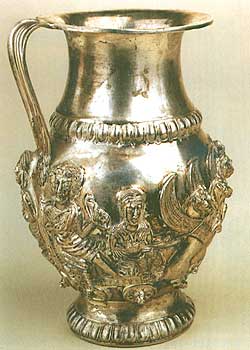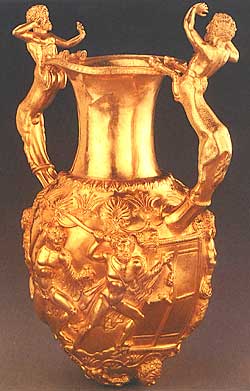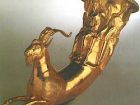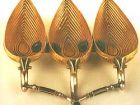VARNA: Nine Tracian Treasures In Varna Archeological Museum
Nine Tracian Treasures
In Varna Archeological Museum
The Varna Archeological Museum is hosting a special exposition of nine selected Tracian treasures. These come from six large museums and reveal the culture and arts of the ancient people who had inhabited the lands of present-day Bulgaria since the times of the Aeneolithic age until the dawning of the Roman Empire (4400 BC - 3rd Century AD). Most of these magnificent objects are made of gold or silver and proudly ranked among the masterpieces of the world cultural and historical heritage. Some of these have been found to be deeply buried like genuine treasures are; others have been discovered during excavation works by prominent Bulgarian archeologists for the last 80 years all over the country. Welcome and enjoy the glamour of the most famous ancient monuments of art found in Bulgaria.
Finds in tomb No. 1 ( a cenopath - a tomb with no sceleton in it) from the Varna Aeneolithic Necropolis, dated between 4400-4200 BC. There is a scepter - a symbol of power, along with numerous adornments made of gold. The total weight of the artifacts is well over 1 kg - qualified as the "world's oldest gold". These comprise only a part of the most sensational discovery in archeology at the close of the 20th century that has changed the ancient history of Europe and the world.
Finds discovered in a mound necropolis near the village of Dabene, Plovdiv Region, date back to the early Bronze Age. Composite gold adornments made of 15,000 tiny beads dating back to the end of the third millennium BC. They bear a resemblance to the so called "Priamos Treasure", discovered by H. Schliemann at Troy in the 19th century.


The Gold Treasure of Valchitran, Pleven, is the richest one from the Late Bronze Age (13th-12th century BC). This ceremonial set comprising nine different vessels and disks is made of 12.5 kg solid gold. Second to none as it is, it reveals the riches of Tracian kings and priests during the time of the Trojan War.
Finds in the mound necropolis near the village of Duvalni, Plovdiv (6th-4th century BC) - gold adornments in all sorts of form and make, along with a series of imported silver bowls are a marvelous example of the Tracian and Greek goldsmith's art.
Finds in the mound necropolis near the village of Duvalni, Plovdiv (6th-4th century BC) - gold adornments in all sorts of form and make, along with a series of imported silver bowls are a marvelous example of the Tracian and Greek goldsmith's art.
The biggest Tracian silver treasure from the village of Rogozen, Vratza (5th-4th century BC) comprises 165 vessels - jugs, phiales (drinking bowls) and chalices. Their total weight is 20 kg and they were a part of the treasury of the Tracian Dynasty of the Triballoi tribe. Some of them are embossed with ornaments of inscriptions of the names of the Tracian kings such as Satokos, (5th century BC) and Kersebleptes (359-341 BC).
The gold treasure from Panagyurishte, Plovdiv (end of the 4th century - beginning of the 3th century BC) weights 6,165 kg. This unique ceremonial set comprising a phiale, an amphora, three rhytons shaped as animals and three jugs with heads of Greek Goddesses probably belonged to one of the Tracian kings and is the best example of the Hellenistic goldsmith's art around the world.
The gold treasure from Panagyurishte, Plovdiv (end of the 4th century - beginning of the 3th century BC) weights 6,165 kg. This unique ceremonial set comprising a phiale, an amphora, three rhytons shaped as animals and three jugs with heads of Greek Goddesses probably belonged to one of the Tracian kings and is the best example of the Hellenistic goldsmith's art around the world.
Finds in a tomb of a Tracian ruler near the village of Zlatnitza - Malomirovo, Yambol Area (mid 4th century BC) - a gold wreath with ornaments, a signet-ring, a greave (shin armour) and a two beautiful rhytons, discovered in 2005 have attracted the attention of the mass media from all over the world.
Silver treasure from the village of Borovo, Russe district (the firts half of the 4th century BC) - a magnificent set of a bowl, a rhyton jug and three other rhytons - in the form of a sphinx, a bull and a horse - belonged to King Cotys I, the powerful Tracian king (385-359 BC).
Finds in the village of Capitan Andreevo (the first half of the 3rd century) - two bracelets, a special neck adornment (called tonque) and a lid of a jewelry box, a silver head of Julia Soaemias, mother of Emperor Elagabalus (218-222 AD) are among the paragons of Roman goldsmith's art found in Bulgaria.
Silver treasure from the village of Borovo, Russe district (the firts half of the 4th century BC) - a magnificent set of a bowl, a rhyton jug and three other rhytons - in the form of a sphinx, a bull and a horse - belonged to King Cotys I, the powerful Tracian king (385-359 BC).
Finds in the village of Capitan Andreevo (the first half of the 3rd century) - two bracelets, a special neck adornment (called tonque) and a lid of a jewelry box, a silver head of Julia Soaemias, mother of Emperor Elagabalus (218-222 AD) are among the paragons of Roman goldsmith's art found in Bulgaria.







